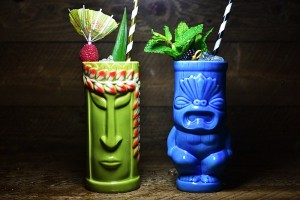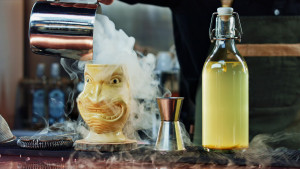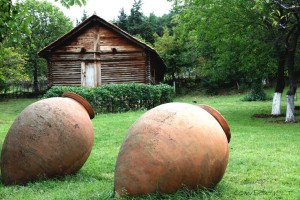Today we have a post from Ben Coffelt, CSW. Ben will leading a session entitled “Tiki Time” as part of SWE’s 43rd Annual Conference, to be held this August in Washington DC. Read on as Ben tells us about a very important part of Tiki culture—the history of the Tiki mug.
The Tiki mug is one of the most beloved and defining aspects of Tiki culture. In the heyday of the Tiki craze, mugs could be found in almost every home in America. Where did the practice of serving elaborate tropical drinks begin and how have they re-emerged? While some would characterize Tiki mugs as ceramic glasses specifically depicting tikis (Polynesian idols), for the purposes of our brief history, we will be referring to all mugs used to serve Tiki drinks as “Tiki mugs.”
The first ceramic mugs were used by Trader Vic at his eponymous restaurant in the 1940s. While the original motivation for using ceramic mugs is unknown, Tiki expert and author of “The Book of Tiki”, Sven A. Kirsten, points to an evolution of the increasingly elaborate presentation of drinks at Polynesian restaurants at the time. One of the first mugs was used for the Samoan Fog Cutter and the first vessel to feature a representation of a Tiki was on a drink called the Tiki Bowl. These mugs helped contribute to the sense of escapism that Tiki bars channeled. Fueled by an increasing American interest in Polynesia and Hawaii, the mug would grow from this humble start.
In 1955, Bob Bryant, a former bartender at Trader Vic’s, opened Tiki Bob’s in San Francisco. This is most likely the birthplace of the first mug to be done in a Tiki idol style. Soon, other Polynesian and Tiki restaurants were having their own mugs made in a greater variety of shapes and done as tikis, coconuts, bamboo, or volcanoes. By the 1960s large manufacturers, such as Otagiri Mercantile Company, began producing them on a commercial scale. Restaurants had their logos added and used them as souvenirs for guests. The trend became so popular that Holland Mold Inc made ceramic molds for people to use at home to create their own Tiki mugs. They often became as important, if not more so, than the drink they held.
By the mid-1970s, Tiki was out of fashion as were the drinking vessels associated with it. Once cherished mugs ended up discarded or donated to thrift stores. Others gathered dust, forgotten on shelves or in cabinets. Classic bars and restaurants closed. Tiki was viewed as old fashioned and discos and nightclubs became the norm.
As Tiki re-emerged in the 1990s it was as a celebrated mid-century aesthetic. Décor and mugs were viewed more as art and pop art pieces, than simple decorations. Vintage mugs became sought after collectibles. Enthusiasts and collectors scoured flea markets for lost gems. The internet revolutionized the ability to hunt down hard to find mugs and offered more information on producers and history than ever before. Ebay currently has 8,000 mugs listed for sale. The website Ooga-Mooga! allow collectors to publicly display their collections and connect with others who are willing to trade or sell mugs.
Now the mug has returned not just at dedicated Tiki restaurants, but many bars will feature one or two Tiki drinks in themed glassware. Contemporary Tiki bars like Three Dots and a Dash in Chicago and Latitude 29 in New Orleans, feature modern, custom takes on mugs or recreations of classic designs often made by Tiki Farm or Bosko. Beautifully constructed cocktails served in elaborately designed ceramicware are perfect for Instagram. Last fall, approximately one thousand people lined up at Disneyland to try to obtain a new limited release. The mug has come full circle back to a place of prominence in American bar culture.
Ben’s session—Tiki Time—will be held on Wednesday, August 14 (2019) at 10:30 am as part of the Society of Wine Educators’ 43rd Annual Conference, to be held in Washington DC.
Are you a conference speaker that would like to provide a preview of your session? Contact Jane A. Nickles at jnickles@societyofwineeducators.org





